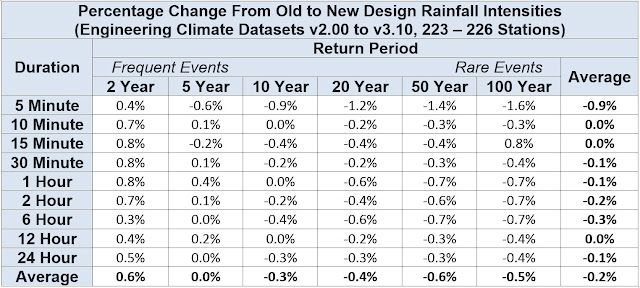What are the trends in regions of Canada that have experienced significant flooding in the past? And do the trends projected by models for long durations (1 day precipitation) match observed data trends? No - some 24-hour trends are decreasing despite models estimating they will go up (or have gone up because of increasing temperatures).
Also, what is happening with observed short duration intensities, the ones responsible for flooding in urban areas, compared to the observed 1-day trends?
The data show short duration and long duration trends diverge. Therefore relying on models of 1 day precipitation to estimate what is happening with short duration, sudden, extreme rainfall should be done with caution.
A couple charts help illustrate these observed data trends and show what is wrong with relying directly on models to project local extreme rainfall.
This is the trend in observed rainfall for southern Ontario climate stations, using median changes in IDF statistics:
 |
| Southern Ontario Extreme Rainfall Trends |
These are the trends for Alberta observed rainfall when new data are added and are reflected in the most current v3.10 datasets:
 |
| Alberta Extreme Rainfall Trends |
In Alberta, long duration intensities decrease significantly (100 year is down by 4% on average). Meanwhile the short duration intensities increase. The long duration decrease is contrary to Environment Canada's simulation models that estimate 1 day rainfall at a sub-continental scale.
In northern Ontario, trends are different than in southern Ontario as shown below:
In northern Ontario the long duration intensities have increased but short duration intensities have decreased on average. So we see short and long duration rainfall trends are diverging when we consider new data.
Climate modellers may suggest that simulated 1 day precipitation can guide what happens during short durations too. Observed data suggest otherwise. Trends actually diverge.
In brief, for this sample of regions shown above, we see these trends:
Location Short Duration Trend Long Duration Trend
Southern Ontario Larger Decrease Decrease
Northern Ontario Decrease Increase
Alberta Increase Decrease
Remember "All models are wrong, some are useful". Climate models do not accurately project changes in extreme rainfall in Canada based on observed data. Furthermore, simulated 1 day precipitation trends from models cannot be used to assume short duration trends related to flooding in urban areas - short and long duration rainfall trends are observed to change in opposite directions in sample regions across Canada.
In northern Ontario, trends are different than in southern Ontario as shown below:
 |
| Northern Ontario Extreme Rainfall Trends |
In northern Ontario the long duration intensities have increased but short duration intensities have decreased on average. So we see short and long duration rainfall trends are diverging when we consider new data.
Climate modellers may suggest that simulated 1 day precipitation can guide what happens during short durations too. Observed data suggest otherwise. Trends actually diverge.
In brief, for this sample of regions shown above, we see these trends:
Location Short Duration Trend Long Duration Trend
Southern Ontario Larger Decrease Decrease
Northern Ontario Decrease Increase
Alberta Increase Decrease
Remember "All models are wrong, some are useful". Climate models do not accurately project changes in extreme rainfall in Canada based on observed data. Furthermore, simulated 1 day precipitation trends from models cannot be used to assume short duration trends related to flooding in urban areas - short and long duration rainfall trends are observed to change in opposite directions in sample regions across Canada.
When using 1 day rainfall trends to estimate short duration trends, given the actual observed data trends above, it may be appropriate to conduct sensitivity analysis on potential shorter duration trends, especially if those shorter durations influence system behaviour (e.g., 'flashy' urban drainage systems). Those short duration trends trends may be in an opposite direction or magnitude than the 1 day trends. For example, in Northern Ontario the 1 day 100-year intensities have increased 2% as a result of the most recent IDF data updates, however the intensities for durations of 2 hours or less have mostly decreased.
The following chart compares the 30 minute, 1 hour and 2 hour 100-year intensity trends with the 24 hour 100-year trends at 226 climate stations across Canada.
The correlation of short duration trends with 24 hour trends is weak with R-squared value of 0.12 for 2 hour trends, 0.06 for 1 hour trends and 0.006 for 30 minute trends. This suggests that short duration trends are not correlated with 24 hour trends.
***
Given recent flooding in British Columbia, it is worthwhile looking at trends in design rainfall intensities in BC. This chart shows that extreme rainfall intensities (red dots with 100-year return period, orange dots with 50-year return period) have not increased for most durations - the 12 hour duration intensities are up slightly on average (less than 0.5% increase), while other duration intensities have decreased by more than 2 % on average (5-minute 100-year intensities).
For the longest duration of 24 hours, intensities have decreased on average - typical 2-year intensities are unchanged on average while the moderate and extreme intensities (5-years, 10-year, 25-year, 50-year and 100-year) have decreased on average.
The following tables shows trends in observed annual maximum rainfall over various durations at BC climate stations with long-term records. These are called the Annual Maximum Series (AMS). Trends in derived design rainfall intensities above (e.g., 2-year to 100-year rainfall rates) follow these trends in AMS.













